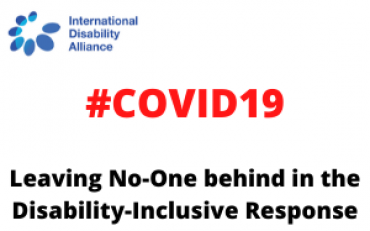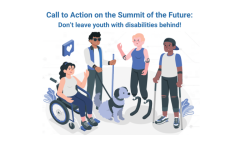This is one story as part of the Voices of People with Disabilities during COVID19 Outbreak series
With the rapidly evolving COVID-19 pandemic, the fear of contagion pushed countries around the world to implement measures such as social distancing to slow the spread of the coronavirus. But amid the fear of the COVID-19 contagion, how can persons with deafblindness, who rely on the use of touch to communicate their needs, do so without fear of coronavirus contagion?
Reaching out to 2%
Amid the COVID-19 pandemic, the World Health Organization recommends social distancing to curb the spread of COVID-19. While we acknowledge that WHO guidelines are for our safety, the question raises: how would persons with deafblindness communicate their needs with others while observing social distancing?
Globally, 2% of the population, or around 155 million people, experience combined hearing and vision impairments – deafblindness. Adding dual sensory impairment due to aging, the number rises to 6% implying as many as 467 million experience a degree of deafblindness during life.
Deafblindness is a distinct disability arising from a dual sensory impairment. Even though some persons with deafblindness are completely deaf and blind, many have some degree of vision and/or hearing senses. It is vital to recognize that persons with disabilities are not a homogenous group. Since persons with deafblindness constitute a diverse group with a broad experience of disability, their required support levels and accessibility requirements vary from person to person.
How do Persons with deafblindness Communicate?
Each person with deafblindness connects, communicates and experiences the world differently. Depending on the level of the vision and hearing impairment, persons with deafblindness may require specific support services, such as interpreter-guides, tactile communication (e.g., tactile sign language, tactile fingerspelling), visual framing (i.e., a sign language that is adapted to fit a limited field of vision with a person who has some degree of a residual sigh), and tadoma (i.e.,. communication through jaw movements, vibrations and the facial expressions of the speaker). It is vital, therefore, that persons with deafblindness access services that meet each individual’s needs and not a combination of services designed for blind or deaf people.
In normal circumstances, hospitals provide services that help patients with deafblindness to communicate their needs through specific support services which might include tactile sign language, lip-reading, hand-held amplification devices, among others. However, during the COVID-19 pandemic, many of these services are hindered. Masks and gloves that healthcare providers are obliged to wear impede the ability to read lips. Even though clinicians might not have the skills and capacity to sign directly on hands of persons with deafblindness, hospitals have stopped allowing in-person interpreters, family members and visitors into the hospitals who otherwise could have provided this help. Due to lack of inclusive and accessible COVID-19 responses, persons with deafblindness are left behind.
Norwegian Example
People with deafblindness are concerned about having a barrier to access information about the COVID-19 pandemic. Geir Jensen, a man with deafblindness and the President of the World Federation of the Deafblind (WFDB) living in Norway, shares the challenges that he faces. Despite Norway having inclusive policies and high-quality support services for deafblind persons, the COVID-19 pandemic has caused many challenges for them.
Geir explains that the accessibility of mainstream media, both government-funded and private covers COVID-19 quite extensively. The accessibility of it is, however, varying. At press conferences held by the government, sign language interpreters on screen are more often than not included. Live captioning (CART) is mostly absent on most channels. However, video, illustrations or text are mostly not accessible for persons with deafblindness. Some text-based online media may be accessed through braille readers and/or synthetic voice, but only for those who are able to use assistive technology.
Currently, with stay-at-home orders, people around the world have switched to working remotely and use platforms such as Zoom, Go-to-Meeting or Skype to hold meetings. However, in majority of cases, the hosts of virtual events and/or webinars fail to make it accessible to persons with disabilities, by not having international sign interpretation available and/or speech-to-text/velotyping.
The general lack of access to interpreter-guides, due to current restrictions, prohibits in many cases persons with deafblindness from accessing information.
For instance, Geir says that he has experienced difficulty to join online meetings such as one on “Persons with Disabilities and COVID-19: How to Ensure Inclusion and Participation”. Geir further explains that the taxi services and interpreter-guide services, which are provided to persons with deafblindness by the Norwegian government, are currently discontinued due to the COVID-19 pandemic. Currently, no face-to-face interpretation, including interpreter-guides, unless critical for life and/or health are made available. Remote interpretation is permitted; however, this is rarely an accessible alternative for persons with deafblindness. Furthermore, he would have had to violate the restrictions and recommendations given by the Norwegian government if he were to travel for work. Geir needs to be accompanied by the taxi driver, which entails touch. Geir further explains that in order to follow communications, he would need to sit very close to his Executive Assistant. “We are strongly advised to keep a social distance of two meters here in Norway. In sum, I am as a person with deafblindness experiencing exclusion from participation, which is paradoxical considering the theme for the meeting”, says Geir.
Norwegian DPOs representing persons with deafblindness have used their publications, online, print/braille and audio to distribute both national and regional news and information to the constituency. Still, it is not enough as many require interpreter-guides to access even this vital information.
WFDB is aware of two cases of persons that were in need of medical assistance and/or treatment, both in the initial phase of the pandemic in Norway. The first incident was related to insecurity for a person with deafblindness whether or not the cancer treatment would be given as planned due to recently imposed restrictions on interpreter-guides, this case contributed to discussions within the Norwegian Deafblind Association with the service providers and led to a broader definition of life and health incidents for interpreter-guides.
The other incident involved an older person that was suddenly admitted to hospital due to a serious health issue. This was clearly within the scope of life and health that constituted the right to interpreter-guide during the stay. Still, confusion regarding whom to bill for the service and interpersonal communication challenges between the involved parties led to a third party stepping in to provide interpreter-guides at the hospital to ensure that the admission would not be cancelled.
Both issues are similar in that the right to interpreter-guides was not actually in question. It was the lack of knowledge, communication skills and decision-making authority on the processing levels that ultimately put these two persons with deafblindness at risk of being discriminated against by the Norwegian health services. It clearly shows that many improvements must be made in preparing disaster reduction plans in public services administration (in line with CRPD Art. 11).
Through all of this, highlighting one positive thing in Norway, Geir points out that the office responsible for organizing and administering interpreter-guide services in Norway has been cooperative. They have listened to their arguments and actively, within the restrictions imposed by the government, managed to find ways of providing assistance, sharing information and resolving any critical issues (especially the two medical incidents) in a dynamic way. It is important to note that the service provider (a public entity), on their own initiative, once these restrictions were imposed, decided to reach out to lonely older persons with deafblindness to ensure they had information on the situation, and sufficient supply of food and medicine.
Actions Taken
Global pandemic brings into focus how important accessibility measures and access to specific support services are, and how much more needs to be done to fully guarantee accessible information. Governments must ensure that persons with deafblindness are also equally protected according to Article 11 of the UN Convention of the Rights of Persons with Disabilities (CRPD).
To reach out to individuals with deafblindness and assist them during the times of pandemic, the World Federation of the Deafblind has prepared a Letter and Tips for persons with deafblindness. The Disability Rights Fund have prepared recommendations to support access to information for persons with Deafblindness to ensure that deafblind persons are not deprived of lifesaving information. In addition, the European Deafblind Union (EDbU), the African Federation of the Deafblind (AFDB), the Latin American Federation of the Deafblind (FLASC) and the World Federation of the Deafblind (WFDB) put together recommendations on inclusive policies from the global deafblind community.

